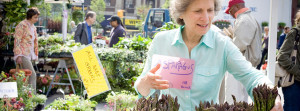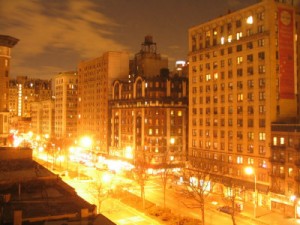Last night, HG made a room temperature Chinese sauce of peanut butter, tea, soya, vinegar, chopped Szechuan preserved vegetables, peanut and sesame oil, chopped garlic, Vietnamese chili garlic, chopped scallions. A lot of ingredients but very simple to prepare. BSK poached and shredded a chicken. Mixed the shredded chicken with the sauce. Surrounded the platter with arugula. HG filled a bowl with room temperature vermicelli mixed with the great peanut sauce and topped it with slivers of cold cucumber. Poured some Gahan India Pale Ale (brewed on Prince Edward Island) and had a great warm weather meal. This brought back memories of cooking teacher/caterer/author Karen Lee and the class where HG and BSK learned to make this dish (and other savory Chinese treats). Many, many decades ago HG and BSK attended Lee’s classes which she held in her small Upper West Side apartment. Ms. Lee was going through some trying times then but her teaching was superb. Clear. Helpful. And the food (which the class ate with gusto) was delicious. HG/BSK’s classmates included the actor Peter Boyle (“Young Frankenstein”, “Joe”, “Taxi Driver”, “Everybody Loves Raymond”) and his wife, Loraine Alterman (she was a reporter for Rolling Stone and John Lennon was the best man at her wedding to Peter); actress Verna Bloom (“Animal House,” “High Plains Drifter”; Stephanie Pierson, the brilliantly witty advertising copywriter, author of many books (“The Brisket Book” is the latest) and long time HG/BSK pal. The class was lively, funny and irreverent. Sadly, Peter Boyle is gone but the remaining cast thrives. Karen Lee’s West Side classes continue but now she’s added a summer session in Amagansett, Long Island. The lady (deservedly) flourishes.
Karen Lee Cooking Classes
September 8th, 2014 § 0 comments § permalink
The West Side Is (was) The Best Side
April 15th, 2013 § 0 comments § permalink
HG has written frequently about the food heaven that was the Upper West Side of Manhattan. Yes, Zabar’s, Murray’s and Barney Greengrass remain — temples of smoked fish and other delicious treats. But, in the days long before the UWS became fully gentrified there were scores of Mom-and-Pop shops, eccentric ethnic restaurants and corner greengrocers that defined the neighborhood’s culinary bent — all have disappeared, crushed by the real estate steam roller. When HG and BSK lived on the West Side during the 1960s and early 1970s the neighborhood was a bastion of rent control. Vast, affordable apartments were legion. Naturally, this attracted writers, artists, musicians, dancers, intellectuals, etc. The neighborhood had an edge. There were plenty of muggers and drug addicts. Petty larceny was the norm. Crazies, huddled in layers of clothing during the warmest weather, wandered the streets mumbling their interior monologues. At night, hookers appeared. There was a melancholy haze over the benches on Broadway where Holocaust survivors, often displaying their concentration camp tattoos, sat ringed in exhaust fumes and polluted sunshine. The great, Nobel Prize-winning author I.B. Singer, a small, pale man in a dark suit and fedora, would chat in Yiddish with these men and women (when he wasn’t feeding pigeons). Impecunious old European refugees favored the Senate Cafeteria on Broadway near 96th Street where they argued endlessly over cups of tea. HG and BSK lived in The Hereford, a moldering 12-story apartment house between West End Avenue and Riverside Drive (glorious views of the Hudson River and the New Jersey Palisades). The building was a repository of the arts. HG and BSK’s dear friend, the composer Michael Small lived with his wife, Lynn, on the fourth floor (HG and BSK lived on the lofty 12th). The Small’s apartment was unusual. Michael’s classmate at Williams College, Charles Gwathmey, the extraordinary architect, had ripped out walls in the apartment creating an exuberant space defined by his beautifully crafted cabinetry. Michael’s grand piano was at stage center. Peter Boyle, the actor (before jumping to fame in Young Frankenstein) lived in the building and joined HG and BSK at a Chinese cooking class. Ted Solotaroff, the visionary critic and editor (founder of The New American Review and lifelong friend of Philip Roth) became a pal of HG and BSK. Here’s a vignette of life at The Hereford: Early one evening Michael summoned HG and BSK to his apartment where he played some of his score to the film Klute (a hit with Jane Fonda as a call girl-in-peril). He went on to write the scores for many memorable films induing All The President’s Men and Marathon Man. After dinner we all went to a literary event at Ted Solotaroff’s apartment. Here, we heard Richard Howard, the poet and translator, read Robert Browning’s My Last Duchess. Memorable. Sadly, Small, Boyle, Gwathmey, Singer and Solotaroff are all gone. Richard Howard is still a figure in New York literary life. And HG continues to remember it all with great fondness.
Young New Yorkers Living in Expensive Closets: Read This And Weep.
October 10th, 2012 § 0 comments § permalink
Some 48 years ago (seems like yesterday). HG, BSK, their two adorable children, their live-in mother’s helper and their poorly trained but decorative standard poodle, lived in a 12th floor Upper West Side apartment with dramatic views of the Hudson River and the New Jersey Palisades. A very spacious residence. Big living room. Big, separate dining room. Nice windowed kitchen and pantry. Four bedrooms and three baths (one en suite). The rent: $274 a month (later raised to $292 and a similar apartment in the same building now rents for $15,000 a month). Ah, rent control, you lovely bit of legislation (of course, obtaining this rent controlled paradise involved some bribery, chicanery and corruption). This did not shock HG, a born and bred New Yorker. In those days the Upper West Side was affordable and diverse. There was still a heavy Jewish influence. Big time theater and entertainment folks (Abe Burrows, Leonard Bernstein, Isaac Stern and many more) lived on Central Park West alongside many affluent professionals and business persons. Side streets from Central Park West to Broadway were gritty (except for W. 67th Street, site of the Des Artistes apartment house and many studios of painters and musicians). Riverside Drive and the Avenues and cross streets west of Broadway were filled with intellectuals and creative types who had more brains and talent than money. Forget Greenwich Village. The Upper West Side was the home of professors, critics, novelists, dancers, journalists, composers, actors, musicians and school teachers. Lots of European intellectuals who had fled Hitler and many Holocaust survivors (the little, pale, Nobel Prize winning writer, Isaac Baashevis Singer, who lived on W. 86th Street, often wrote about them). The Heresford (West Side apartment houses often had British names, a touch of Anglophile class) where HG and BSK lived, had much artistic ferment. Among its residents were Peter Boyle (before Hollywood and TV fame); film composer Michael Small, the critic and editor Ted Solotaroff; Gary Null, the health and sex writer, guru and radio personality. There were also some Broadway dancers, the cantor of a major synagogue and lesser artistic lights. The Upper West Side was filled with movie theaters showing art films (the New Yorker, Thalia and Symphony) and plus the first run houses (Loew’s 83rd, the Beacon,etc.). Food was a neighborhood obsession. Zabar’s, of course, but also Murray’s (preferred by some smoked fish aficionados) and Barney Greengrass (unsurpassed sturgeon). Middle European restaurants like Eclair and dairy restaurants like Steinberg’s and Paramount. Gitlitz’ Delicatessen on Broadway and 78th ( much superior in HG’s informed opinion, to Katz’s, Carnegie or 2nd Avenue Deli). The jewel of the West Side was the Tip Toe Inn (on Broadway near 86th Street). A huge place with a huge menu. Everything was delicious and inexpensive (the New York Public Library has a nice collection of old menus….Here’s a link to Tip Toe’s 1954 menu. Be astonished). There was a rotisserie in the Bretton Woods Hotel (86th and Broadway) that barbecued ducks and chickens. Sunday dinners for HG and BSK often featured one of those juicy, crisp skinned ducks and an avocado-sweet onion-sliced orange salad. Chinese restaurants were clustered around Broadway and 96th and they were very good (the first Szechuan restaurant in New York was on Broadway and 95th). There were also some Cuban/Chinese places where you could get good shrimp dishes plus Moros y Cristianos (black beans and rice) Fairway didn’t exist but for those who liked to eat at home there were butchers like Endicottt Meats and Nevada Market (where you could get some exotic stuff including bear, in season). Good bakeries. Mom and Pop greengrocers. Citarella’s for fish. Broadway Nut Shop for sweets. Daitch Dairy (79th and Broadway) for tub butter and cheese. Bretton Wood Rotisserie for barbecued ducks. HG and BSK were not plutocrats but could afford all of these good things. Yes, the Upper West Side had lots of junkies, hookers, muggers and burglars. Their presence made West Siders feel superior to residents of the antiseptic Upper East Side. Now, let HG make you young folks really jealous. HG, BSK and family spent all summer plus spring and fall weekends at their Fire Island home. Built atop a dune it had panoramic views of the Atlantic Ocean and Great South Bay sunsets. The family bought it for $40.000. HG’s first Fire Island house (in 1959) cost $4,000 ($1,000 for land and $3,000 for two bedrooms, bathroom, kitchen, living room and deck). In 1960, HG added two more bedrooms, another bathroom and additional decking. Cost: $2,000. That’s right. The numbers for these Fire Island properties are correct. Read and weep.


